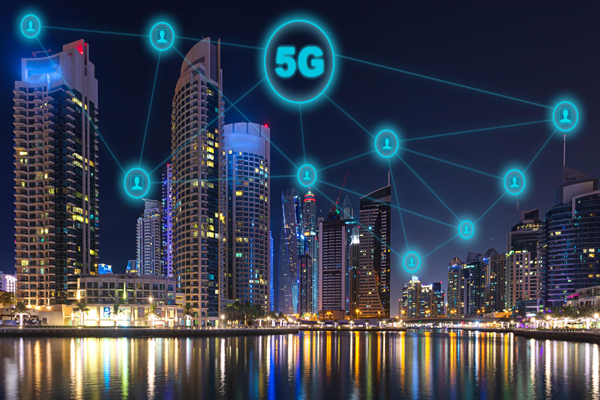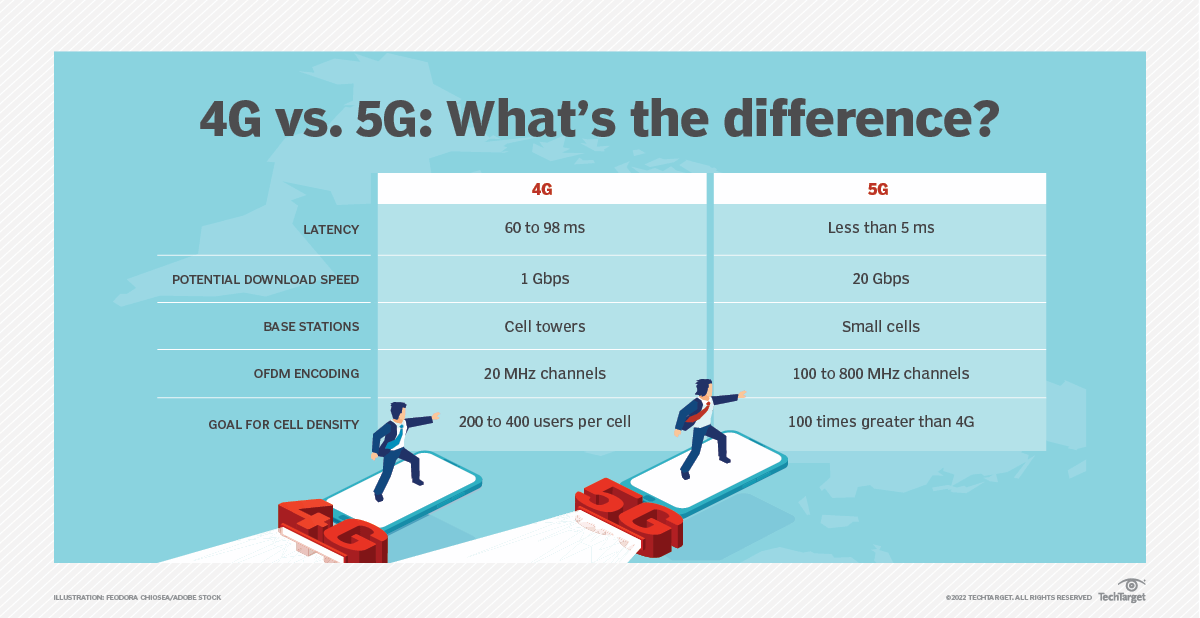5G vs 4G: Learn the key differences between them

In a perfect world, each generation builds on its predecessors and thrives in ways that previous generations could not. In a way, the new generation is responding to the problems created by the older generation.

This is especially relevant for generations of mobile networks and cellular technologies. In fourth-generation wireless versus fifth-generation wireless, the goal of 5G is not only to surpass 4G network capabilities, but to meet and exceed 4G's goals in general speed, latency, and density.
The 4G era has seen innovation in various networking trends, such as the growth of the Internet of Things, the increase in the number of smartphones, and the remote and mobile workforce. These trends made huge strides throughout the 2010s, creating the need to support faster speeds and higher cell densities. Coming to 5G, many experts hope it will solve the problems introduced by 4G.
Before organizations jump on the 5G bandwagon, however, they must understand the differences between 4G and 5G network architectures and determine how both architectures may impact business operations. This feature delves into these differences and discusses what these key differences mean for organizations around the world.
Defining the Differences Between LTE, 4G, and 5G
4G. Fourth-generation wireless is the precursor to 5G and the fourth-generation mobile network technology. In the 2010s, 4G became the newest and most innovative generation of cellular technology, and within a decade it was ubiquitous. Some of the promises of 4G include enhanced cell density, improved VoIP capabilities, and greater bandwidth.
LTE. Long Term Evolution was developed as a 4G standard during the reign of 4G. LTE is the global gold standard for wireless broadband and lays the foundation for 5G networks. Both 4G and LTE support a wide variety of traffic types, something previous generations struggled to do, and 5G now has to improve.
5G. Fifth generation wireless is the latest generation of cellular network technology. Small early deployments started in the late 2010s, but 5G won't be widespread until the mid-2020s. The touted benefits of 5G include faster network speeds and the ability to communicate in real-time.
How does 5G work?
5G has a variety of new features and capabilities, including network slicing, orthogonal frequency division multiplexing (OFDM), and massive multiple-input multiple-output.
5G also introduces another new standard called 5G New Radio (NR), which is designed to replace LTE. 5G NR will build on the best features of LTE and bring new benefits such as more energy savings and enhanced connectivity for connected devices.
Additionally, compared to 4G LTE's sub-6 GHz wavelengths, 5G can operate on a new high-frequency spectrum called millimeter wave (mmWave), which operates on wavelengths between 30 GHz and 300 GHz. Because of the millimeter wave spectrum, 5G requires new small cells to operate and operate.
Key differences between 4G and 5G network architectures include:
- Delay
- Potential download speed
- base station
- OFDM coding
- cell density

While 4G and 5G differ in many ways, 5G is designed to make up for the shortcomings of 4G. Learn more in this 4G vs 5G comparison table.
Compare latency, speed and bandwidth
Delay. The biggest difference between 4G and 5G is latency. 5G promises low latency under 5ms, while 4G latencies range from 60ms to 98ms. In addition, the lower latency brings advances in other areas, such as faster download speeds.
Potential download speed. While 4G introduced various VoIP capabilities, 5G builds on and enhances those promises, namely potentially fast download speeds. 4G has download speeds of 1 Gbps, and 5G aims to increase that speed tenfold to reach a maximum download speed of 10 Gbps.
base station. Another key difference between 4G and 5G is the most common base stations needed to transmit the signal. Like its predecessors, 4G transmits signals from cell towers. However, 5G uses small cell technology, and operators will deploy high-band 5G in pizza box-sized small cells in multiple locations due to its faster speeds and millimeter-wave bands. 5G will still use cell towers in its lower spectrum.
Because of mmWave frequencies, operators must deploy small cells in various regions. While higher frequencies than cellular technology to date, mmWave signals are weaker and travel shorter distances. Small cells must often be placed in 5G-enabled areas to ensure the signal reaches users and businesses.
OFDM coding. OFDM is used to separate different wireless signals into different channels to avoid interference, which also provides greater bandwidth. Because OFDM encodes data on different frequencies, 4G and 5G download speeds can be boosted because those networks will have their own signal channel, rather than a channel shared between them. 4G uses 20 MHz channels, while 5G will use 100 MHz to 800 MHz channels.
cell density. Small cell technology enables 5G to provide higher cellular densities and enhance network capacity. While these are also the promises of 4G, 5G is expected to succeed where its predecessor fell short, as 4G never quite hit its high goals for general speeds. With 5G, networks will be denser, meaning they have more capacity to support more users and connected devices, increasing mobile device and connection capacity.
Despite touting 5G's advancements, its promises won't come to fruition on day one. Operators will need time to address the pitfalls and differences that 5G may create. Organizations shouldn't immediately expect the best, says network engineer Lee Badman.

Take a look back at the history of the mobile web and see how download speeds and latency have changed over the generations.
5G expectations and reality
Early technological promises are not always guaranteed. Organizations that want to assess the differences in network architecture between 4G and 5G should take a step back and look at what 4G promises, what 4G actually delivers, and what that means for the reality of 5G. Caution is key, according to Badman, because goals are not always achievable in the real world.
For example, Badman said, one of the goals of 4G is that it will reach general speeds of 100 Mbps to 1 Gbps. In practice, these speeds averaged from 7 Mbps to 43 Mbps. That doesn't mean 4G is bad, or that the original goal was a lie. Rather, these goals lay the foundation for what 5G should and can achieve. For example, 5G's download speed and low-latency goals are an extension of 4G's original goals.
However, as Badman warns, 5G won't accomplish everything on day one. These achievements may take years or may not materialize at all. It is critical for organizations and network teams to understand that the expectations and realities of 4G and 5G are mutually exclusive.
While 5G may enhance operations, it may not live up to expectations right away. Still, 5G has the potential to enhance operations and address shortcomings that 4G failed to address. How 5G will enable this in a long-term, global fashion remains to be seen.